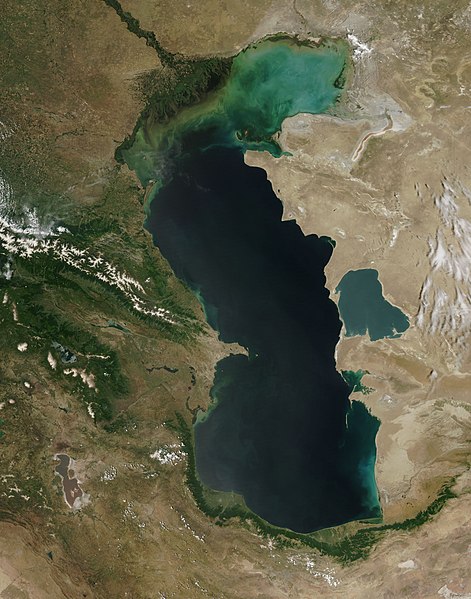Fáìlì:Caspian Sea from orbit.jpg

Ìtóbi ìkọ́yẹ̀wò yìí: 471 × 599 pixels. Àwọn ìgbéhàn míràn: 188 × 240 pixels | 377 × 480 pixels | 603 × 768 pixels | 804 × 1,024 pixels | 1,609 × 2,048 pixels | 4,400 × 5,600 pixels.
Fáìlì àtìbẹ̀rẹ̀ (4,400 × 5,600 pixel, ìtóbi faili: 3.44 MB, irú MIME: image/jpeg)
Ìtàn fáìlì
Ẹ kan kliki lórí ọjọ́ọdún/àkókò kan láti wo fáìlì ọ̀ún bó ṣe hàn ní àkókò na.
| Ọjọ́ọdún/Àkókò | Àwòrán kékeré | Àwọn ìwọ̀n | Oníṣe | Àríwí | |
|---|---|---|---|---|---|
| lọ́wọ́ | 09:16, 14 Oṣù Kẹfà 2010 |  | 4,400 × 5,600 (3.44 MB) | Originalwana | higher res |
| 15:10, 8 Oṣù Kejì 2005 |  | 550 × 700 (67 KB) | Pixeltoo | Caspian sea by space Nasa |
Ìlò fáìlì
Kò sí ojúewé tó únlo fáìlì yìí.
Ìlò fáìlì káàkiri
Àwọn wiki míràn wọ̀nyí lo fáìlì yìí:
- Ìlò ní af.wikipedia.org
- Ìlò ní als.wikipedia.org
- Ìlò ní am.wikipedia.org
- Ìlò ní ang.wikipedia.org
- Ìlò ní an.wikipedia.org
- Ìlò ní arc.wikipedia.org
- Ìlò ní ar.wikipedia.org
- بحر قزوين
- ويكيبيديا:صور مختارة/الفضاء والكون/نظرة إلى الخلف
- ويكيبيديا:ترشيحات الصور المختارة/بحر قزوين
- ويكيبيديا:صورة اليوم المختارة/ديسمبر 2016
- قالب:صورة اليوم المختارة/2016-12-23
- مستخدم:قائمة أكبر البحيرات والبحار في المجموعة الشمسية
- ويكيبيديا:صورة اليوم المختارة/يوليو 2020
- قالب:صورة اليوم المختارة/2020-07-16
- ويكيبيديا:صورة اليوم المختارة/يوليو 2023
- قالب:صورة اليوم المختارة/2023-07-26
- Ìlò ní arz.wikipedia.org
- Ìlò ní ast.wikipedia.org
- Ìlò ní as.wikipedia.org
- Ìlò ní av.wikipedia.org
- Ìlò ní azb.wikipedia.org
- Ìlò ní az.wikipedia.org
- Ìlò ní bat-smg.wikipedia.org
- Ìlò ní be.wikipedia.org
- Ìlò ní bg.wikipedia.org
- Ìlò ní bh.wikipedia.org
- Ìlò ní bn.wikipedia.org
- Ìlò ní br.wikipedia.org
- Ìlò ní bs.wikipedia.org
- Ìlò ní bxr.wikipedia.org
- Ìlò ní ca.wikipedia.org
- Ìlò ní ce.wikipedia.org
- Ìlò ní ckb.wikipedia.org
- Ìlò ní co.wikipedia.org
- Ìlò ní cs.wikipedia.org
Ìfihàn ìlò míràn púpọ̀ fún fálì yìí.



